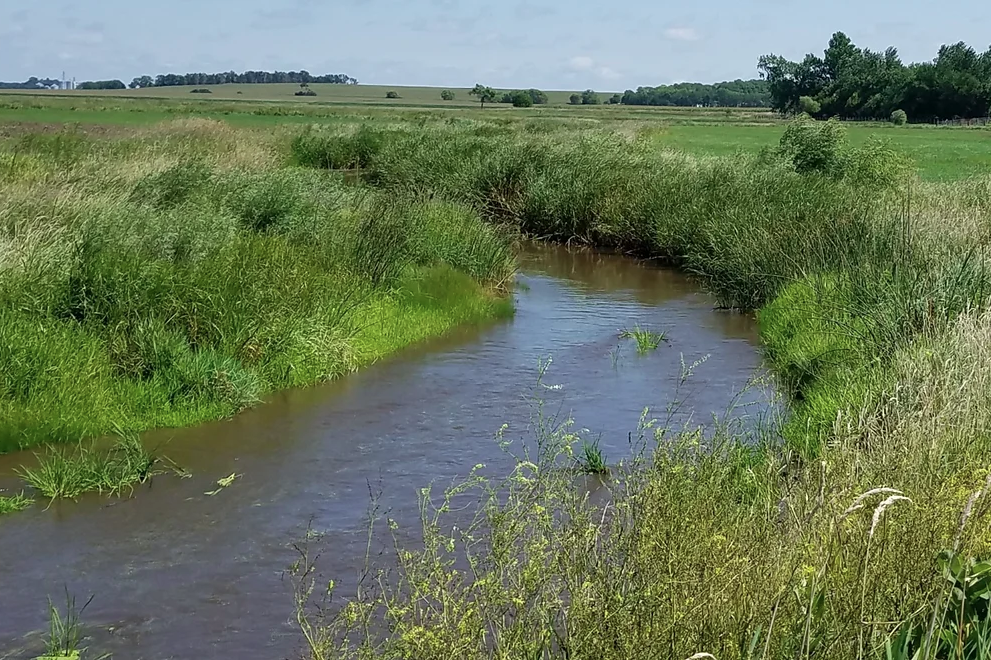
Joshua Haiar/South Dakota Searchlight
SIOUX FALLS – Keeping cattle waste out of the river that runs through the state’s largest city will cost about $11 million over the next five years, and the city will pay more than half the price.
One of the designers of the water quality program that money pays for, however, told an audience in Sioux Falls that past investments have paid off.
The Big Sioux River is polluted with dissolved soils, agricultural chemicals and livestock waste beyond levels safe for uses like fishing and swimming. City, federal and state money has been used for a little over a decade to pay landowners to leave strips of tallgrass or other vegetation in the land along the banks of a river or a tributary. The root systems in those buffer strips catch and filter out pollutants before they enter the water, and also prevent erosion.

During Thursday’s Big Sioux Stewardship Summit, program developer Barry Berg, said his team and partners have enrolled over 100 stream miles into their buffer strip program since its inception.
“We finally reached the century mark with the program,” he said during a morning presentation.
The enrolled areas now total more than 4,000 acres, with an additional 250 to 300 slated for enrollment this spring, Berg said.
Under the primary model of the program, livestock are blocked from bank access from April through September. Farmers are allowed to cut the grass for hay after June 15. The idea is to keep cattle out of streams during hot summer months when they’re most likely to wade in and defecate, spiking E. coli levels.
Berg said advancing the program is an arduous process that involves enrolling landowners in conservation agreements, coordinating federal and state funding streams, and adapting grazing and haying practices to better protect streambanks and riparian vegetation.
A focal point of the effort is Skunk Creek, which flows about 70 miles from Brant Lake into the Big Sioux River near Sioux Falls. Skunk Creek now contributes over half of the water that flows over the falls at Falls Park and through the city, due to a diversion upstream on the Big Sioux near the airport.
Skunk Creek historically carries a lot of E. coli into the river. But today, he said 44% of its banks in the program’s footprint and 48% of adjacent pastureland acres have been enrolled. And that’s making a big difference, he said. It’s possible, he said, for the state’s integrated water quality report to take Skunk Creek off its list of impaired water bodies if the program keeps its momentum.
“Back in 2013 and 2014, we had samples on Skunk Creek with 50 to 70% exceeding standards,” for permissible E. coli and suspended solids, he said. “Now we’re down around 10 to 11% exceeding. If we get down below 10 and hold that for two years in the integrated report, they’re gonna say, ‘Hey, we’re passing. Skunk Creek is no longer impaired.’”

For Skunk Creek, “no longer impaired” would mean its waters would be safe for non-immersion recreational activities like kayaking or canoeing. Because it feeds the Big Sioux, that would move the river’s water quality within city limits closer to what advocates want: a swimmable river.
Participating farmers see financial benefits, Berg added. He described working with one landowner to calculate returns on haying the buffer land. The landowner made more through incentive payments and hay than he would have by planting corn or soybeans.
When the last five-year phase of the project wraps up this summer, the water quality investments will have supported 16 watering stations, over 4,000 feet of fencing, 12,000 feet of pipe, and four barns, built with manure-trapping pits beneath them. Additionally, the final phase also saw over 1,000 acres of cover crop planted and 900 more acres enrolled in the buffer program.
The next five years will continue that work, with $11 million already earmarked. That includes about $5.8 million from Sioux Falls, $3.2 million in federal grants and funding, $1.4 million in local cash and donations, $465,000 from Dell Rapids, and $263,000 from the East Dakota Water Development District.
Berg said his long-term goal is to enroll 75% of Skunk Creek’s streambanks.
“If we can get there, I believe we’ll see it delisted for E. coli,” he said. “We’re already close.”
Travis Entenmann, director of Friends of the Big Sioux River, said the effort is not only about compliance and conservation, but the city’s future. A clean river, he said, is one that people can use.
“It’s a huge opportunity for us for tourism,” he said. “The idea that it could be 90 degrees outside and there’s not families recreating in the river; it is kind of sad. And we should want better.”
A voluntary, incentive-based approach is how the state primarily tries to tackle the issue of E. Coli contamination in its waters, but he said more could be done.
“The three things that I believe will clean our river are regulation, enforcement of regulation, and land use change,” he later said.
